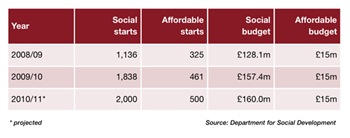Programme for Government update
agendaNi finds good progress against government housing commitments but funding has fallen far short of expectations.
After a slow start, the Programme for Government’s target for building social housing is within reach but progress on affordable builds is slightly slower and just over half of the promised investment has materialised.
The Programme for Government also pledged to invest £925 million in social and affordable housing by 2011. However, projected figures estimate that £490.5 million will be invested by the end of this financial year.
The main promise was to provide 10,000 social and affordable houses by 2013, of which 7,500 would be social and 2,500 affordable.
Affordable housing is achieved where the costs do not exceed 35 per cent of gross household income, according to the Semple review. It covers both shared equity and shared ownership products; the co-ownership scheme is the DSD’s main mechanism for assisting first-time buyers.
Statistics show that 3,760 social and affordable starts had been made by April 2010 (2,974 social, 786 affordable).
Projections for this financial year would take that figure up to 6,260 (4,974 social, 1,286 affordable). This would reach 62.6 per cent of the Executive’s overall house-building target, 66.3 per cent of the planned new social housing and 51.4 per cent of the planned new affordable housing.
In practice, this means that a further 2,526 social homes and 1,214 affordable homes must be built in the next two financial years.
The DSD and the Housing Executive were also due to “establish a robust system for assessing future demand for social housing” by 2011. This will be known as housing market analysis, as opposed to the current housing need assessment, and it is currently being developed.
Asked why the present system was not sufficiently robust, Alex Attwood said that it “offers an effective basis” for planning the Social Housing Development Programme but was designed to focus mainly on the social sector. It therefore provides “only a limited understanding of events in the wider housing market.”
“Social housing,” he added, “does not exist in isolation” and housing market analysis will incorporate the existing system of assessing housing need while also providing an overall analysis of the drivers and dynamics within the wider housing market.
“The improved system should also allow planning for housing to be linked more effectively with other forms of social and economic development. The current and good system will be upgraded to a better one,” said Attwood.
The construction of social housing, he pointed out, was “beginning to make up for the direct rule years when new build did not keep pace with demand.”
A February 2010 model estimated that at least 2,000 additional new social homes were needed each year to meet ongoing need. This rose to 2,500 if the direct rule backlog, which dates back to 2001, is to be tackled.
Attwood concluded: “This is all further evidence that new build budgets should be protected, state housing monies put on a long-term secure financial footing and at a time of mass unemployment and growing personal and housing stress, new build remains essential.”
As promised, a procurement strategy for social housing was implemented on time; this was launched in October 2008.
It brought housing associations together in four procurement consortia and was based on the use of long-term construction contracts.






